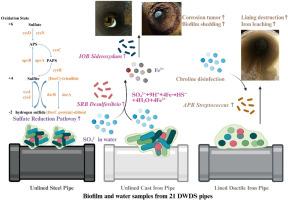Material-driven microbiologically influenced corrosion mechanisms in drinking water distribution systems
IF 12.4
1区 环境科学与生态学
Q1 ENGINEERING, ENVIRONMENTAL
引用次数: 0
Abstract
Microbially influenced corrosion (MIC) poses critical challenges to drinking water distribution systems (DWDS) by accelerating infrastructure degradation and compromising water quality through metal release and biofilm-derived contaminants. Current understanding remains limited regarding how pipe material and protective linings interact with attached biofilm to drive MIC. To address this, we conducted a comprehensive investigation integrating morphological characterization, microbial community profiling, and biochemical analysis across 21 field-aged pipes (cast iron, ductile iron, steel) with service durations up to 50 years. Initial assessments revealed that unlined steel pipes exhibited more accelerated corrosion compared to cement-lined systems, correlating with tuberculation severity and liner degradation. Biofilm quantification demonstrated 13.5-fold higher bacterial densities on unlined surfaces (P<0.001), attributed to corrosion-induced microtopography. Taxonomic profiling identified material-specific enrichment: unlined metal pipes harbored iron-oxidizing Sideroxydans (1.12%) and sulfate-reducing Desulfovibrio (5.19%), whereas lined pipes accumulated iron-reducing Shewanella (0.59%). Elevated sulfate promoted SRB dominance in steel pipes, with assimilatory sulfate reduction genes (cysI/cysJ) identified as key functional markers for sulfate to H₂S transformation. In contrast, cement-lined ductile iron pipes fostered acidogenic Streptococcus proliferation (1-log increase), correlating with iron dissolution (R²=0.929) via lactic acid production. Crucially, we delineated two MIC guilds: redox-active taxa including Desulfovibrio and Sideroxydans governed by Ca²⁺-HCO₃⁻-SO₄²⁻ gradients in unlined pipes versus chlorine-enriched acidogenic Streptococcus in lined pipes. These findings delineate material-driven MIC mechanisms, establishing a new non-invasive monitoring strategy for corrosion risk assessment. By linking effluent biomarkers to pipe wall biofilm dynamics, this approach offers a promising alternative to excavation-dependent inspections.

饮用水分配系统中材料驱动的微生物影响腐蚀机制
微生物影响腐蚀(MIC)加速了基础设施的降解,并通过金属释放和生物膜衍生污染物损害了水质,给饮用水分配系统(DWDS)带来了严峻的挑战。目前对管道材料和保护衬里如何与附着的生物膜相互作用以驱动MIC的了解仍然有限。为了解决这个问题,我们对21根使用年限长达50年的现场老化管道(铸铁、球墨铸铁、钢)进行了全面的调查,包括形态表征、微生物群落分析和生化分析。初步评估显示,与水泥内衬系统相比,未内衬钢管的腐蚀速度更快,这与结核的严重程度和内衬退化有关。生物膜定量显示,由于腐蚀引起的微地形,无内衬表面的细菌密度高出13.5倍(P<0.001)。分类分析证实了物质特异性富集:无衬里的金属管道中含有氧化铁的铁氧弧菌(1.12%)和硫酸盐还原的脱硫弧菌(5.19%),而衬里的管道中含有铁还原的希瓦氏菌(0.59%)。升高的硫酸盐促进了SRB在钢管中的优势地位,同化硫酸盐还原基因(cysI/cysJ)被认为是硫酸盐向H₂S转化的关键功能标记。相反,水泥衬球墨铸铁管促进产酸链球菌增殖(增加1-log),与铁通过乳酸产生的溶解相关(R²=0.929)。至关重要的是,我们描绘了两个MIC行会:氧化还原活性类群,包括Desulfovibrio和Sideroxydans,由无衬里管道中的Ca + -HCO₃-SO₄²⁻控制,以及衬里管道中富氯的产酸链球菌。这些发现描述了材料驱动的MIC机制,为腐蚀风险评估建立了新的无创监测策略。通过将流出物生物标志物与管壁生物膜动力学联系起来,这种方法为依赖于挖掘的检测提供了一种有希望的替代方法。
本文章由计算机程序翻译,如有差异,请以英文原文为准。
求助全文
约1分钟内获得全文
求助全文
来源期刊

Water Research
环境科学-工程:环境
CiteScore
20.80
自引率
9.40%
发文量
1307
审稿时长
38 days
期刊介绍:
Water Research, along with its open access companion journal Water Research X, serves as a platform for publishing original research papers covering various aspects of the science and technology related to the anthropogenic water cycle, water quality, and its management worldwide. The audience targeted by the journal comprises biologists, chemical engineers, chemists, civil engineers, environmental engineers, limnologists, and microbiologists. The scope of the journal include:
•Treatment processes for water and wastewaters (municipal, agricultural, industrial, and on-site treatment), including resource recovery and residuals management;
•Urban hydrology including sewer systems, stormwater management, and green infrastructure;
•Drinking water treatment and distribution;
•Potable and non-potable water reuse;
•Sanitation, public health, and risk assessment;
•Anaerobic digestion, solid and hazardous waste management, including source characterization and the effects and control of leachates and gaseous emissions;
•Contaminants (chemical, microbial, anthropogenic particles such as nanoparticles or microplastics) and related water quality sensing, monitoring, fate, and assessment;
•Anthropogenic impacts on inland, tidal, coastal and urban waters, focusing on surface and ground waters, and point and non-point sources of pollution;
•Environmental restoration, linked to surface water, groundwater and groundwater remediation;
•Analysis of the interfaces between sediments and water, and between water and atmosphere, focusing specifically on anthropogenic impacts;
•Mathematical modelling, systems analysis, machine learning, and beneficial use of big data related to the anthropogenic water cycle;
•Socio-economic, policy, and regulations studies.
 求助内容:
求助内容: 应助结果提醒方式:
应助结果提醒方式:


